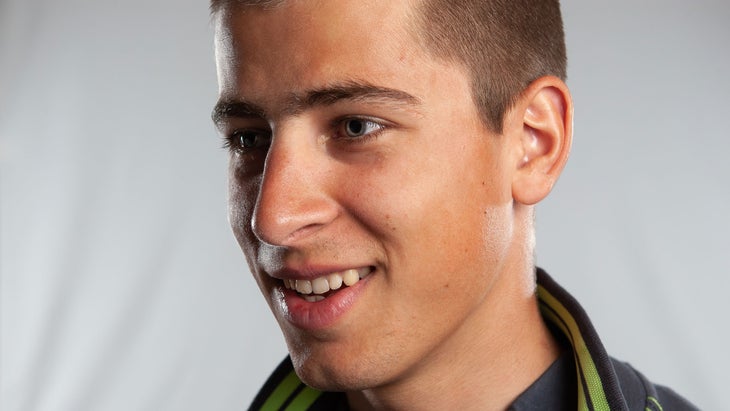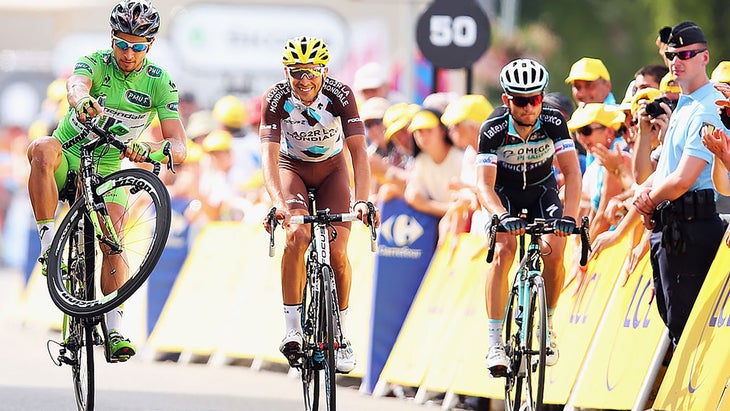Peter Sagan, the most important male professional road cyclist of the last decade, cannot envision his life apart from his sport—even when he someday retires.
“With my name in cycling, I will definitely have to stick with it, but we will see at what level,” Sagan told me. “I think about [being] a manager at a WorldTour team or something, but that’s a big responsibility. I don’t know—I have time to figure it out.”
Sagan does have time to figure things out. He will turn 33 in January, which is late middle age by pro cycling standards. I sat down with Sagan this past June at a nondescript rental house in Emporia, Kansas, and his post-racing future was among my topics of intrigue. He had parachuted into the American Midwest for two days to participate in Unbound Gravel, the unofficial Super Bowl of gravel cycling. These days gravel has become the playground for recently-retired stars of the Tour de France—think of it as cycling’s version of the PGA Senior Tour. I wondered if Sagan was investigating a post-retirement career path.
Gabriele Uboldi, Sagan’s personal media liaison, chided me for bringing up the “R” word. “He’s only 32 years old, eh—he’s not 40,“ Uboldi barked. Sagan, too, seemed uncommitted to delving too deeply into the topic. His participation at Unbound Gravel was almost by chance, he said, because his bike sponsor, Specialized, had arranged for him to stop in Kansas en route from a training camp in Utah back to Europe.
“I can have some experience in gravel—I said yeah, let’s do it,” Sagan, who hails from Slovakia, said. “Unlucky for us it started to rain the last 60 kilometers, but I am still happy I did it.”
When I mentioned that riders of his stature have carte blanche in their post-racing careers, he shrugged. I brought up his former teammate, two-time Tour champion Alberto Contador, who had launched a development team in Spain and become a television personality after calling it quits. Was that a model he might pursue?
“I’m already supporting some young guys in Slovakia, but I don’t see myself in Slovakian cycling like Alberto is in Spain,” he said. “I’m supporting the team where I grew up, and we already have a few good guys, so we are doing well. But to open a team in Slovakia of the size that Alberto did in Spain isn’t going to work because of sponsorship money.”
“Anyway, I have a lot of time to think about it.”
OK, point taken. Of course there is one other reason to ask about Sagan’s future in the sport. Just a few seasons ago Sagan was the most thrilling racer on the planet, capable of winning Tour de France stages, cobbled classics, and world championship titles, seemingly with ease. His penchant for popping wheelies and recording zany YouTube videos breathed much-needed character into a stale sport of Type-A personalities. In a 2017 Outside feature story, Bill Gifford wrote that Sagan “might be the star who saves bike racing.”
Then, over the course of 18 months starting in late 2020, Sagan’s Midas touch evaporated. Last season he won just one race: a sprint stage at the Tour of Switzerland. He went winless at the Tour de France for the third season in a row, and even dropped out of the Tour of Flanders due to a lack of fitness fitness.
Just a few weeks ago, Italian newspaper La Gazetta Dello Sport asked Sagan if he still felt like he could still win. He responded with a somewhat icy answer.
“I don’t like this question. I’m doing my best, like always, to be ready to fight at the highest level. If I didn’t believe in it, I wouldn’t do it,” Sagan told the publication.
Amid this precipitous drop off in results, I too wondered if Sagan was closer to the end of his career than the beginning. I asked if he felt like the same version of himself from five years ago.
“I am the same,” Sagan told me.
I tried again. If he divided his career into different eras—brash youngster, seasoned champion, cagy veteran—which was he in now?
Sagan looked tired as he pondered my inquiries.
“It is true, I am not 20 years old anymore. I’m 32, and I have a son now,” he said. “You are now looking at everything with experience, and you are growing older—I don’t want to say you are getting boring—but you can’t do things the way you did when you were 20. You are never going to be the same.”
The truth lies somewhere in that answer. Peter Sagan heads into the 2023 season at a crossroads in his career. Perhaps he’s merely rebounding from a slump, but maybe he’s just not the same juggernaut he was a few seasons ago. I don’t think he, or anyone around him, knows for sure. Like all sports, cycling is a test of physical strength, tactical acumen, and confidence. Some riders never regain a trust in themselves after a fallow period. Other do. Most recently, British sprinter Mark Cavendish won four stages at the 2021 Tour de France after going winless at the race for five editions. Could Sagan rebound like Cavendish? As a fan of cycling, I hope he can.
So, what changed for Sagan during those 18 months? Younger stars matured. He switched teams. Sagan also caught COVID not once but twice, and tested positive a third time. Each instance stopped his training and racing campaign dead in its tracks, and caused plenty physical and emotional consternation.
“It was crazy. What happens when you test positive? It becomes a mystery in your own head,” Sagan told me. “Even if you miss just training—you are preparing for two or three months and then boom, you are really sick, ten days at home, too sick to ride the rollers. And after that you have to start again, but there is no time because the competitions are coming. Everything in your body is running differently, and you have these up and down moments and feel depressed.”
Pro road cycling also changed during this stretch. Sagan was once seen as the sport’s unicorn of versatility, a top sprinter who could also win stage races, soar over high mountains and cobblestones, and even win a mountain-bike race here and there. His success put to bed the old assumption that modern riders had to specialize in either sprints or climbs, but not both. And Sagan started winning WorldTour races at age 20, a relative anomaly in a sport that—at the time, anyway—rewarded longevity.

Today, many of the sport’s biggest stars are cut from Sagan’s mold: all-rounders under the age of 30. Belgian Wout van Aert, Brit Tom Pidcock, and Dutchmen Mathieu van der Poel, can all climb, sprint, race on- and off-road, and win almost any race they enter. Slovenian Tadej Pogačar and Colombian Egan Bernal both won the Tour de France at age 21. Sagan sees the shift as a positive development.
“It used to be the guys winning the Tour de France were 27, 28 when they started to win, even the new generation is changing things,” Sagan said. “This is not what cycling was 20 years ago, and I feel that every year it is getting better and young riders are getting more professional.”
Sagan’s stop in Kansas marked his first race in the United States in three years, and he noted that American cycling had also changed greatly amid the pandemic. For a decade, Sagan was top-billed at the Amgen Tour of California, where he collected a record 17 stage wins as well as the overall title in 2015. Sagan’s dominance there boosted his celebrity status across North America, and prompted him to return multiple times a year to compete in smaller races, like the USA Pro Challenge and Tour of Alberta
“California was the greatest race—when people ask me what was my favorite race, I say it was it was that and the Tour Down Under, but California was maybe even better,” Sagan said. “You had always good weather. It was perfect for preparation. Good fans. It was beautiful.”

But that era is over, and all of the America’s major professional stage races have disappeared, sunk by financial losses. The Amgen Tour of California shuttered in 2019, and its demise marked a turning point in U.S. pro cycling. The professional road scene retreated just as gravel races like Unbound Gravel, SBT GRVL, and the Belgian Waffle Ride flourished. Now, the mass-participant gravel scene seems to have surpassed road racing in terms of participation and media interest.
Why can’t pro road cycling make it in America? Sagan seemed frustrated by the question.
“It does not make sense because this is such a big country, and you have the NBA, NHL, NFL, Major League Baseball, and everything has millions of dollars, and then poor cycling has nothing,” Sagan said. “California was perfect.”
I asked him what he thought about the participant-based gravel scene, where the biggest races are similar to Italian Gran Fondo-style race rides. He answered by replaying his experience in the 100-mile Unbound Gravel race. It rained. He snapped selfies and shook hands with fans. Lots of people came up to him to say hello. Everyone had a nice ride. When I told Sagan that Unbound Gravel was now perhaps the biggest bike race in the U.S., he scowled.
“This… this I don’t understand—it’s a different kind of cycling in America,” he said. “But you cannot build cycling from just one race.”
The conversation started to wane. I could tell that Sagan was getting tired, and soon he’d be whisked away to the airport for a flight away from the midwest, far from gravel, back to the familiarity of European professional road racing. Before that, though, one more question about retirement.
Did Sagan see a future for himself in the U.S. after his career ended? The inquiry caught him off guard.
“This? This I don’t know,” Sagan said, laughing. “We will see what I decide to do—this will be interesting.”
You cannot argue with that.


